This article, Buteyko: For the Reversal of Chronic Hyperventilation, was written by bio-medical engineer Peter Kolb to explain the basics of the physiology of Dr. Buteyko's theory to doctors and other biological scientists.

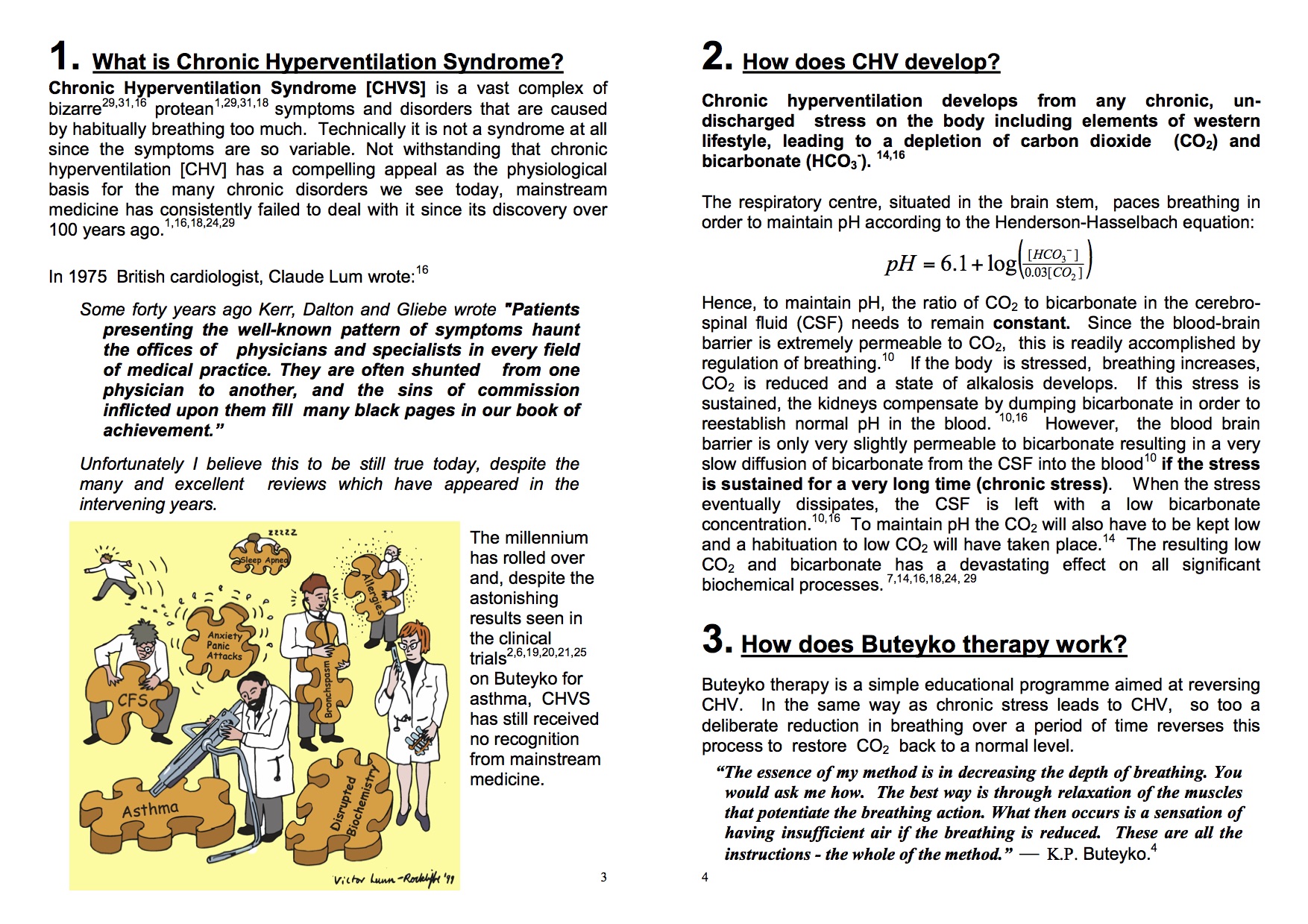


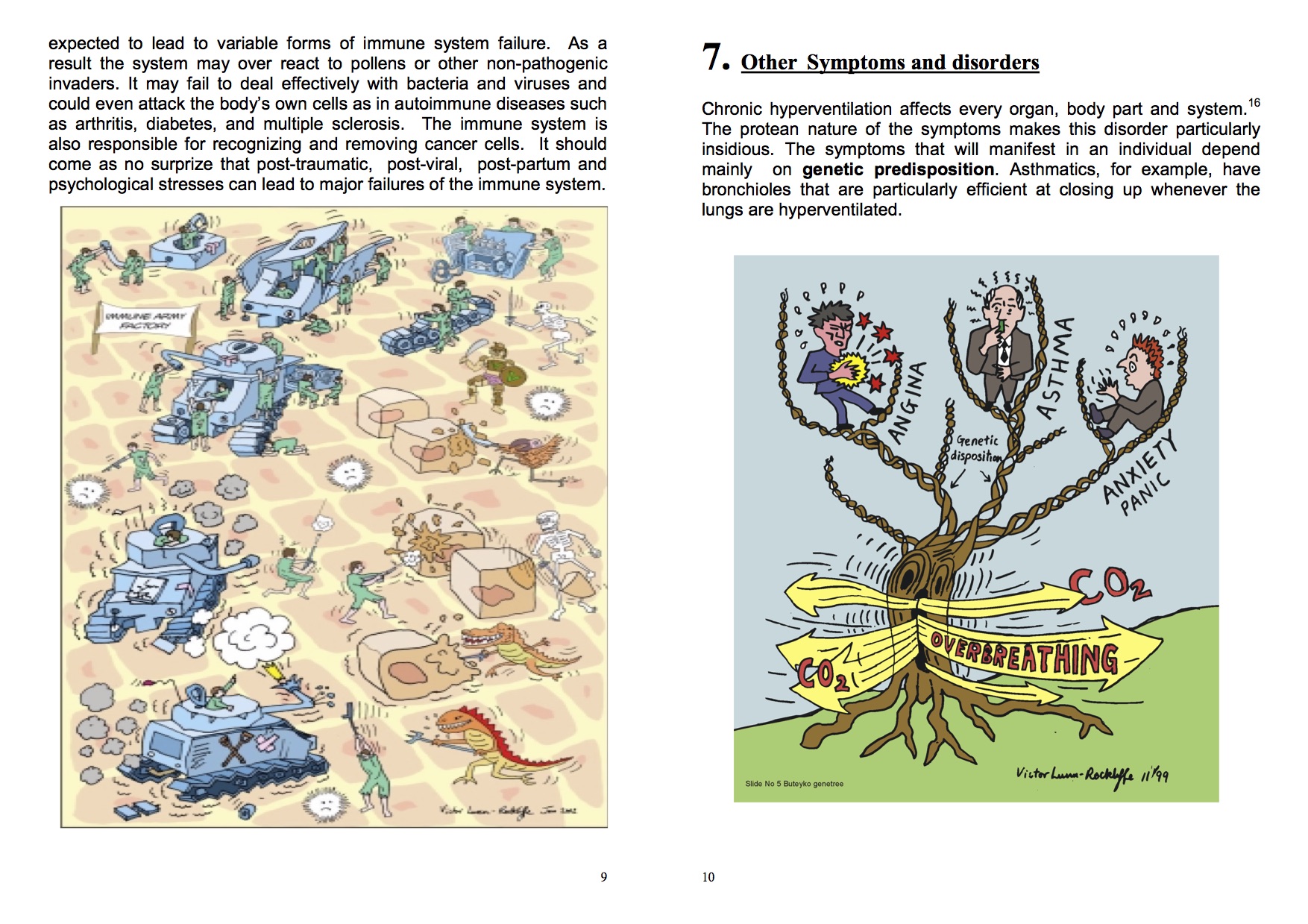
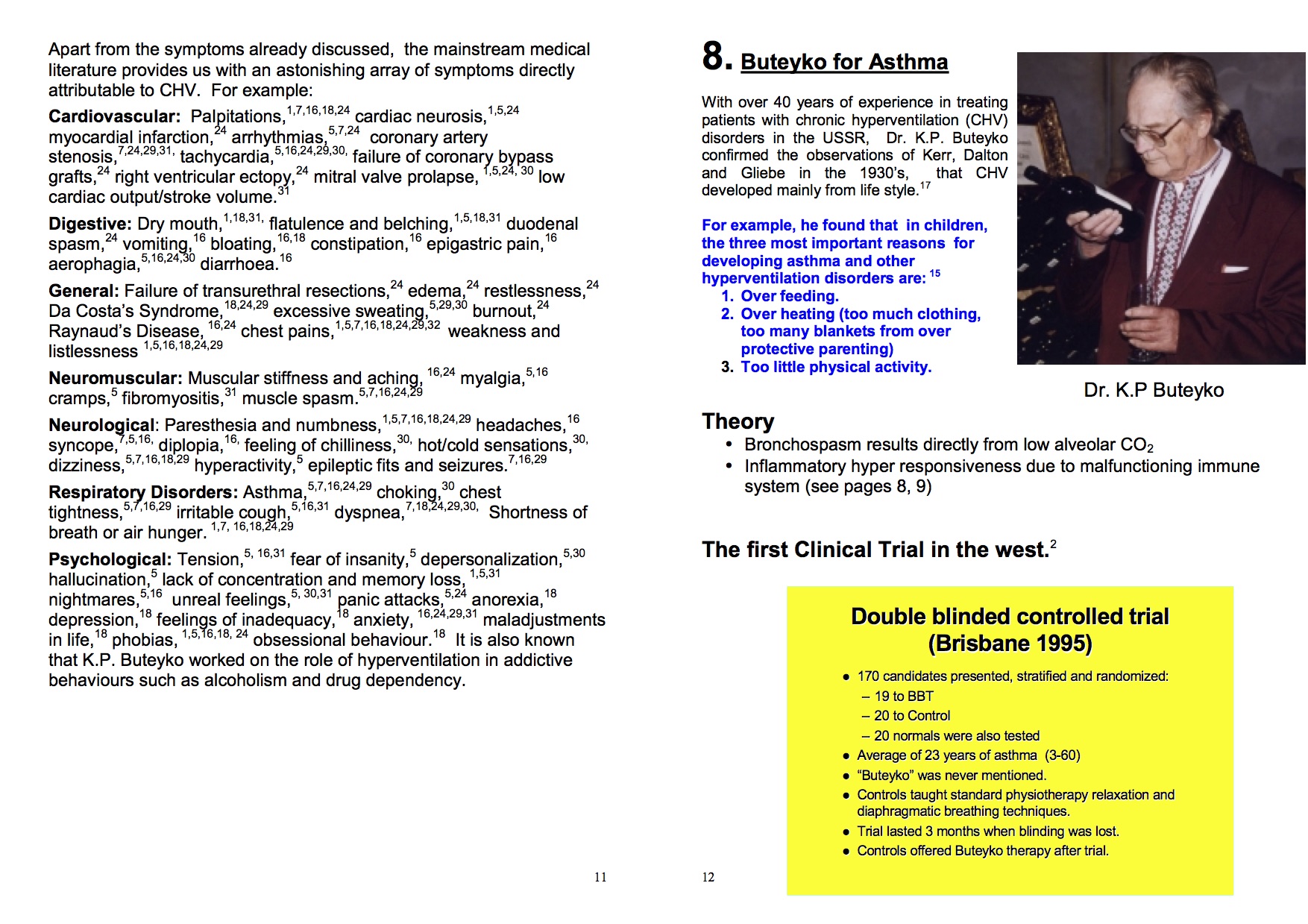
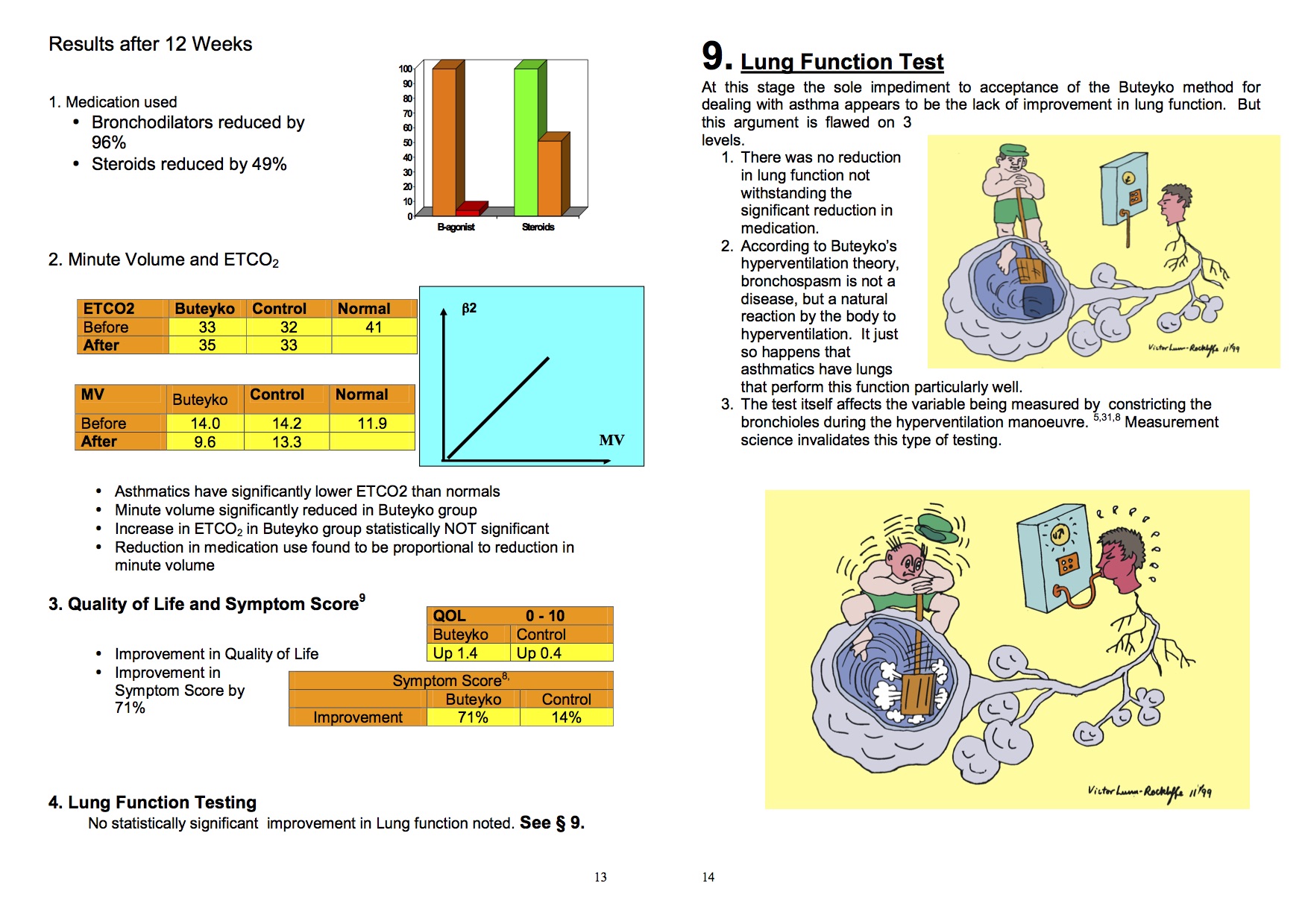
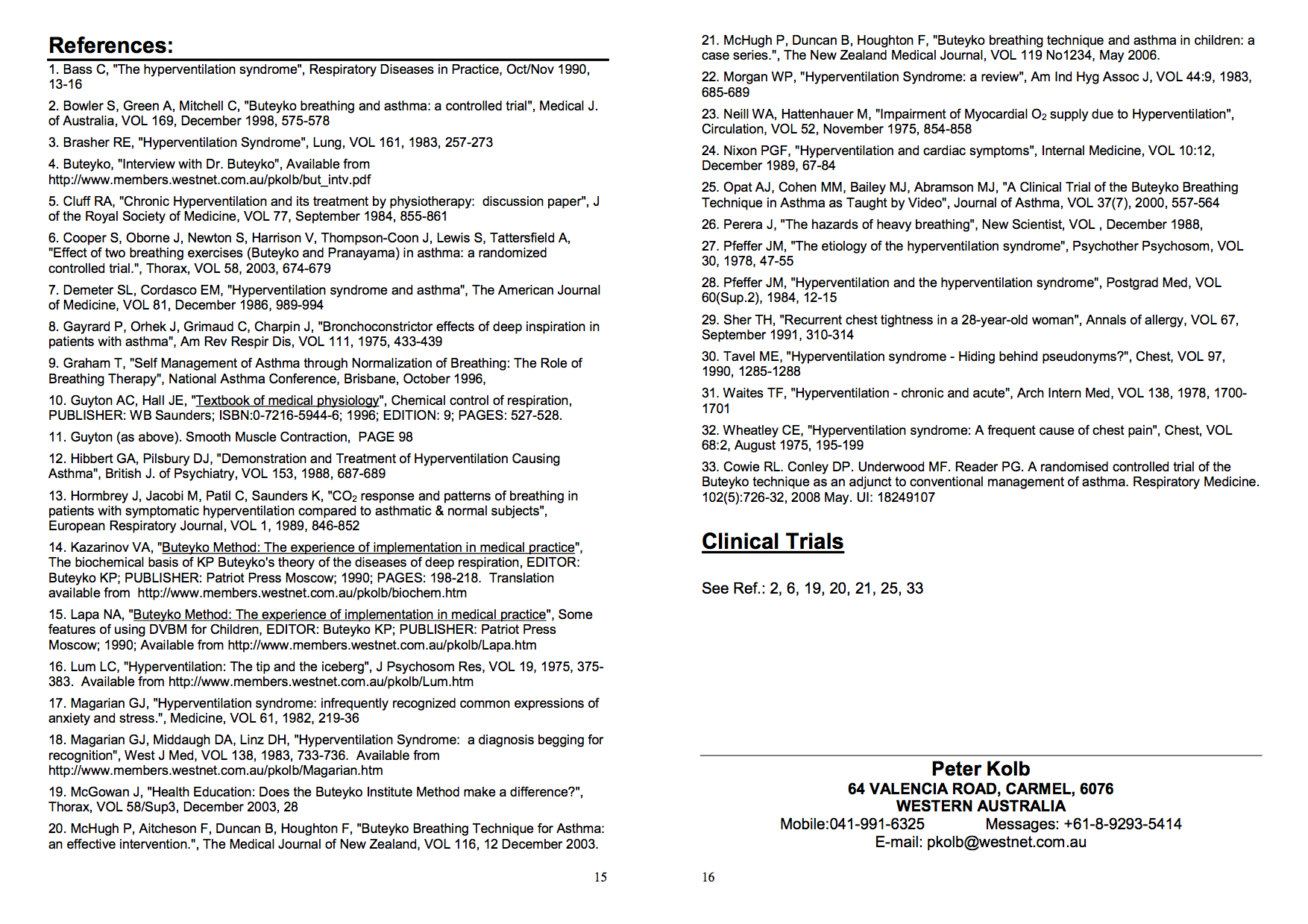
Clinical Trials and Medical Literature
Allergy (European Journal of Allergy and Clinical Immunology) 2010 JW Strider, CG Masterson, PL Durham
Treatment of mast cells with carbon dioxide suppresses degranulation via a novel mechanism involving repression of increased calcium levels
Background: Intranasal noninhaled delivery of carbon dioxide (CO2) is efficacious in the symptomatic treatment of seasonal allergic rhinitis. The goal of this study was to determine whether and how 100% CO2 inhibits mast cell degranulation, thereby possibly contributing to the reduction of symptoms in seasonal allergic rhinitis.
Conclusions: Results from this study provide the first evidence of a unique regulatory mechanism by which CO2 inhibits mast cell degranulation and histamine release by repressing stimulated increases in intracellular calcium. Thus, our data provide a plausible explanation for the reported therapeutic benefit of noninhaled intranasal delivery of 100% CO2 to treat allergic rhinitis.
CO2 inhibits mast cell degranulation, thereby possibly contributing to the reduction of symptoms in seasonal allergic rhinitis.
Conclusions: Results from this study provide the first evidence of a unique regulatory mechanism by which CO2 inhibits mast cell degranulation and histamine release by repressing stimulated increases in intracellular calcium. Thus, our data provide a plausible explanation for the reported therapeutic benefit of noninhaled intranasal delivery of 100% CO2 to treat allergic rhinitis.
Thorax Journal 2006 000:1-7doi 101136/thx2005 054767 CA Slader, HK Reddel, LM Spencer, EG Belousova, CL Armour, SZ Basnic-Anticevich, FCK Thien, CR Jenkins.
Results after applying Buteyko techniques for 12 weeks
- Reliever usage – median reduction of 86%
- Preventer usage – median reduction of 50%
New Zealand Medical Journal Vol 119 No 1234 ISSN 1175 8716 May 2006 Patrick McHugh, Bruce Duncan and Frank Houghton, Gisborne, New Zealand
Results after applying Buteyko techniques to children with asthma for 12 weeks
- Reliever usage – median reduction of 66%
- Preventer usage – median reduction of 41%
- 11 courses of prednisone given 3 months before the trial vs. 1 course of prednisone given three months after the trial.
Proceedings of the American Thoracic Society, 2006;3:A530. Foothills Hospital Medical trial, Calgary, Alberta. May 2006. Robert Cowie, MD
Results after applying Buteyko techniques for 6 months
- Asthma control improved from 41% to 75%, an increase of 34% – Decrease of ICS was 39%
- Elimination of ICS was 21%
Thorax Journal December 2003 Vol 58 Supplement III J. McGowan. Education and Training Consultant, Acorn Nursing Agency, Glasgow.
Results after applying Buteyko techniques for 6 months. – Symptoms reduction 98%
- Reliever usage – median reduction of 98%
- Preventer usage – median reduction of 92%
Thorax 2003;58:674-679 S. Cooper, et al.
Results after applying Buteyko techniques in Nottingham, UK
- Reliever usage – median reduction of 100%
- Preventer usage – median reduction of 41.5%
New Zealand Medical Journal 2002 Vol 116 No 1187 ISSN 1175 8716 Gisborne, New Zealand Patrick McHugh, , Fergus Aitcheson Bruce Duncan and Frank Houghton
Results after applying Buteyko techniques to children with asthma for 12 weeks – Reliever usage – median reduction of 85%
– Preventer usage – median reduction of 50%
Medical Journal of Australia 1998; 169:575-578. Simon D Bowler, Amanda Green and Charles A Mitchell
Results after applying Buteyko techniques for twelve weeks:
- Reliever usage – median reduction of 96% (from daily median of 943ug to 39ug)
- Preventer usage – median reduction of 49% (from daily median 1500ug to 765ug)
- Minute Volume – median reduction of 4.6L/min (from 14 L/min to 9.6 L/min)
New Zealand Medical Journal 12 December 2003, 116 (1187):710-716.McHugh P, Aitcheson, Duncan B, Houghton F, Buteyko Breathing Technique for asthma: an effective intervention.
Results after applying Buteyko techniques for 6 months:
- Reliever usage – median reduction of 85%
- Preventer usage – median reduction of 50%
“Conclusions: BBT is a safe and efficacious asthma management technique. BBT has clinical and potential pharmaco-economic benefits that merit further study.”
Asthma 2000; 37(7): 557-564. 1999, Alfred Hospital, Prahan, Australia Opat AJ, Cohen MM, Bailey MJ, Abramson MJ, A clinical trial of the Buteyko Breathing Technique in asthma as taught by a Video, J
18 patients with mild to moderate asthma were taught the Buteyko method by a video and compared with 18 control subjects (Opat et al, 2000). The study found a significant improvement in quality of life and significant reduction in inhaled steroid use.
1990, Shevchenko’s Central Hospital, Kiev, Ukraine
Results:
- 50 patients with radiation sickness due to Chernobyl’s nuclear plant disaster.
- 82% of patients had considerable improvement in blood analysis, cardiovascular parameters (blood pressure, pulse, etc.), work of the digestive system, and reduction in medication.
- No cases of side effects or complications due to the breathing exercises were reported.
(p.221, Zimchenko & Romanenko, 1991).Zimchenko VN & Romanenko NF, Conclusions on practical trial of Buteyko method, conducted in Department of Radiation Pathology of Central Republican Hospital of Shevchenko region (Ukraine) during 06.03.1990-07.04.1990 [in Russian], in Buteyko method. Its application in medical practice, ed. by K.P. Buteyko, 2nd ed., 1991, Titul, Odessa, p.222- 227.
1981, Sechenov’s Medical Institute, Moscow, USSR 52 children (34 in-patients and 18 out-patients; 3-15 years old) with regular asthma attacks (once per day or more); 41 of them had pneumonia, 27 rhinitis, 36 chronic tonsillitis. All had problems with breathing through the nose, palpitations, and were broncho-dilator users.
- In 1-5 days the patients were able to stop the attacks, cough, blocked nose, and wheezing, using the method. Observations in 1-3 months:
- Cessation of serious attacks or a total disappearance of the symptoms in 83% – some improvement in 17%.
- Their average CP increased from 4 to 30 sec
- CO2 from 25 to 36 mm Hg.
- Higher blood concentrations of IgA, IgM, IgG, and IgE
- Blood pressure normalized
- Forced expiratory volume raised over 5 times.
(Khoroscho, 1982). Khoroscho AE, Interview with K. P. Buteyko (1982), in Buteyko method. Its application in medical practice, ed. by K.P. Buteyko, 2nd ed., 1991, Titul, Odessa, 168-180. 1968, Institute of Pulmonology, Leningrad, USSR
50 patients with severe bronchial asthma, hypertension and stenocardia > success rate 95%
NOTE: The British Medical Thoracic Society has approved the Buteyko Breathing Method as a treatment option for Doctors to recommend for asthmatics.
Chronic excessive breathing, usually referred to as 'chronic hyperventilation,' was noted by the medical community long before Dr. Buteyko began his research in the 1950's.
Dr. DaCosta (1871): noted increased depth of breathing in wounded soldiers in the American Civil War. The more serious the injury, the stronger the breathing. Called this "irritable heart."
Dr. William Kerr and colleagues (1937): coined the term 'hyperventilation syndrome.' Now usually referred to as 'chronic hyperventilation syndrome' (CHVS).
Drs. Soley and Shock (1938): Hyperventilation Provocation Technique (HVPT). Symptoms of various chronic illnesses can be induced by deliberate deep breathing/hyperventilating.
Sir Thomas Lewis (1940): 'Soldier's heart' and 'Effort syndrome.'
Dr. K. Buteyko (1957): the 'disease of deep breathing.'
Dr. Claude Lum: 'Hyperventilation: the tip and the iceberg' (1975). The effects of chronic hyperventilation on the cardio-vascular system. The Papworth Method (1977).
Dr. Gregory Magarian: 'Hyperventilation syndrome: a diagnosis waiting for recognition' (1983).
Discovery of Nitric Oxide production in the paranasal sinus
The Buteyko method has long advocated strict adherence to nasal breathing even during exertion/exercise; there are numerous reasons/benefits to nasal breathing including the production of nitric oxide in the paranasal sinus and distribution of nitric oxide if the breathing is through the nose. Nitric oxide has an antibacterial effect and also increases pulmonary oxygen uptake by enhancing vasodilation in the lungs. http://www.ncbi.nlm.nih.gov/pubmed/18951492
1. Lundberg JO, Farkas-Szallasi T, Weitzberg E, Rinder J, Lidholm J, Anggaard A, Hokfelt T, Lundberg JM, Alving K. High nitric oxide production in human paranasal sinuses. Nat Med 1995;1:370–373.
More recent research (Stamler et al, 2015) indicates that nitric oxide plays a vital role in the respiratory cycle.
"Stamler (the lead researcher) and colleagues demonstrate that nitric oxide is essential for the delivery of oxygen to the cells and tissues that need it."
"Doctors have long known that a major disconnect exists between the amount of oxygen carried in the blood and the amount of oxygen delivered to the tissues. Until now, they had no way to explain the discrepancy. The new findings show that nitric oxide within the red blood cell itself is the gatekeeper to the respiratory cycle - nitric oxide makes the cycle run."
"The simplified textbook view of two gases carried by hemoglobin is missing an essential element - nitric oxide - because blood flow to tissues is actually more important in most circumstances than how much oxygen is carried by hemoglobin. So the respiratory cycle is actually a three-gas system."
"Prof. Stamler says their study shows they have discovered the molecular basis of what controls blood flow in the respiratory cycle. The team believes nitric oxide is the key to oxygen delivery - and without it the respiratory cycle cannot run."
http://www.eurekalert.org/pub_releases/2015-04/cwru-bef041015.php
http://www.rtmagazine.com/2015/04/red-blood-cells-need-nitric-oxide-deliver-oxygen
http://www.medicalnewstoday.com/articles/292292.php

